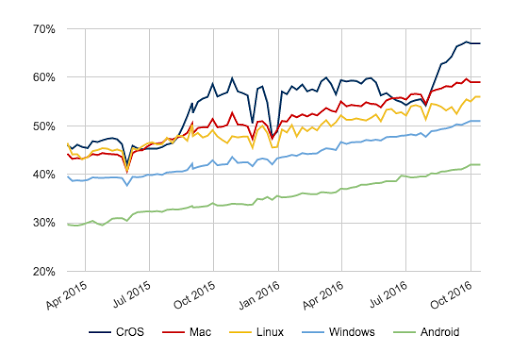วันศุกร์ที่ 4 พฤศจิกายน 2016
โพสต์ข้ามผลิตภัณฑ์จากบล็อกด้านการรักษาความปลอดภัยของ Google
การรักษาความปลอดภัยมีความสําคัญต่อเว็บมาโดยตลอด แต่ความท้าทายเกี่ยวกับการย้ายข้อมูลเว็บไซต์ทําให้ไม่สามารถนํา HTTPS มาใช้ได้เป็นเวลาหลายปี เพื่อให้เว็บที่ปลอดภัยยิ่งขึ้นสําหรับทุกคน Google ได้ทํางานร่วมกับคนอื่นๆ จํานวนมากในระบบนิเวศออนไลน์เพื่อทําความเข้าใจและรับมือกับความท้าทายเหล่านี้ได้ดียิ่งขึ้น ซึ่งนั่นทําให้เกิดการเปลี่ยนแปลงอย่างแท้จริง อนาคตที่เว็บจะมีการใช้ HTTPS อย่างแพร่หลายนั้นอยู่ไม่ไกล การท่องเว็บอย่างปลอดภัยจะกลายเป็นมาตรฐานสําหรับผู้ใช้ Chrome
วันนี้เราจะเพิ่มส่วนใหม่ลงในการ์ดรายงาน HTTPS ในรายงานเพื่อความโปร่งใส ซึ่งจะมีข้อมูลเกี่ยวกับการใช้งาน HTTPS ที่เพิ่มขึ้นเมื่อเวลาผ่านไป มากกว่าครึ่งของหน้าที่ผู้ใช้โหลดและ 2 ใน 3 ของเวลาทั้งหมดที่ผู้ใช้ Chrome เดสก์ท็อปใช้เป็นการใช้งานผ่าน HTTPS และเราคาดว่าเมตริกเหล่านี้จะเพิ่มขึ้นต่อไปอีกมาก

ขณะช่วงการเปลี่ยนผ่านส่วนที่เหลือในเว็บไปใช้ HTTPS เราจะยังคงคอยดูแลให้การย้ายไปใช้ HTTPS ให้เป็นไปอย่างราบรื่น และให้เกิดประโยชน์ทางธุรกิจพร้อมการรักษาความปลอดภัยที่เพิ่มขึ้น ปัจจุบัน HTTPS เปิดใช้ประสิทธิภาพที่ดีที่สุดที่เว็บจะให้ได้ พร้อมฟีเจอร์ที่เป็นประโยชน์ต่อ Conversion ของเว็บไซต์ ซึ่งรวมถึงสองฟีเจอร์ใหม่ เช่น Service Workerหรือ การสนับสนุนแบบออฟไลน์ และฟีเจอร์ข้อความ Push จากเว็บ ตลอดจนฟีเจอร์เดิมที่มีอยู่ เช่น การป้อนข้อมูลบัตรเครดิตโดยอัตโนมัติและ API ตําแหน่งทางภูมิศาสตร์ HTML5 ที่มีประสิทธิภาพเกินกว่าจะใช้แค่กับ HTTP ที่ไม่ปลอดภัย เช่นเดียวกับทุกการย้ายข้อมูลเว็บไซต์ครั้งสำคัญที่จะมีขั้นตอนบางอย่างที่เจ้าของเว็บไซต์ควรปฏิบัติตาม เพื่อให้แน่ใจว่าการย้ายเว็บไซต์ในส่วนของการจัดอันดับการค้นหาจะเป็นไปอย่างราบรื่นเมื่อเปลี่ยนไปใช้ HTTPS และเพื่อช่วยเหลือในเรื่องการดังกล่าว เราได้โพสต์คําถามที่พบบ่อย เพื่อช่วยให้เว็บไซต์ย้ายได้อย่างถูกต้อง และเราจะยังคงปรับปรุงหลักพื้นฐานในการทำเว็บไซต์ให้ดียิ่งขึ้นต่อไปด้วย
เราได้เห็นหลายเว็บไซต์ประสบความสําเร็จจากการย้ายเว็บไซต์โดยมีผลกระทบที่ไม่สลักสำคัญอะไรในการจัดอันดับการค้นหาและการเข้าชม Brian Wood ผู้อํานวยการฝ่าย SEO การตลาดของ Wayfair ซึ่งเป็นเว็บไซต์ค้าปลีกขนาดใหญ่ได้แสดงความคิดเห็นว่า "เราย้ายข้อมูล Wayfair.com ไปยัง HTTPS ได้โดยไม่ส่งผลต่อการจัดอันดับของ Google หรือการเข้าชมจากการค้นหาทั่วไปใน Google ที่มีนัยสำคัญเลย เราดีใจมากที่ตอนนี้เว็บไซต์ Wayfair ทั้งหมดใช้ HTTPS ได้อย่างเต็มรูปแบบ" CNET ซึ่งเป็นเว็บไซต์ขนาดใหญ่ด้านข่าวสารเทคโนโลยีก็ได้ผลลัพธ์ที่คล้ายกัน "เราย้าย CNET.com ไปยัง HTTPS สําเร็จเมื่อเดือนที่แล้ว" John Sherwood รองประธานฝ่ายวิศวกรรมและเทคโนโลยีของ CNET กล่าว "ตั้งแต่ตอนนั้นก็ไม่มีการเปลี่ยนแปลงในการจัดอันดับของ Google หรือการเข้าชมจากการค้นหาทั่วไปใน Google"
เจ้าของเว็บไซต์ที่มีโฆษณาในเว็บไซต์ของตนควรตรวจสอบประสิทธิภาพและรายได้จากโฆษณาอย่างละเอียดรอบคอบในระหว่างการย้ายข้อมูลเว็บไซต์ขนาดใหญ่ ส่วนหนึ่งของการเข้าชมจากโฆษณาของ Google ที่แสดงผ่าน HTTPS เพิ่มขึ้นอย่างมากในช่วง 3 ปีที่ผ่านมา โฆษณาทั้งหมดที่มาจากทุกแหล่งที่มาของ Google รองรับ HTTPS เสมอ ซึ่งรวมถึง AdWords, AdSense หรือ DoubleClick Ad Exchange ส่วนโฆษณาที่ขายโดยตรง เช่น โฆษณาผ่าน DoubleClick for Publishers ยังคงต้องออกแบบให้ใช้งานร่วมกับ HTTPS ได้ดี นั่นหมายความว่าโฆษณาที่มาจาก Google ที่แสดงในเว็บไซต์จะไม่มีการเปลี่ยนแปลงหลังจากเปลี่ยนไปใช้ HTTPS พาร์ทเนอร์ผู้เผยแพร่โฆษณาหลายรายเห็นว่าเป็นจริงดังกล่าวหลังเปลี่ยนเป็น HTTPS สําเร็จ "เราไม่พบผลกระทบใดๆ ที่มีต่อรายได้จาก AdX เมื่อเปลี่ยนไปใช้ SSL" Jason Tollestrup ผู้อํานวยการฝ่ายการโฆษณาแบบเป็นโปรแกรมของ Washington Post กล่าว
เมื่อการย้ายข้อมูลไปยัง HTTPS ทําได้ง่ายยิ่งขึ้น แผนการต่อไปคือเราจะทำให้เว็บปลอดภัยโดยค่าเริ่มต้น เช่นนี้แล้วเราอยากให้คุณเริ่มวางแผนการย้ายไป HTTPS วันนี้เลย
